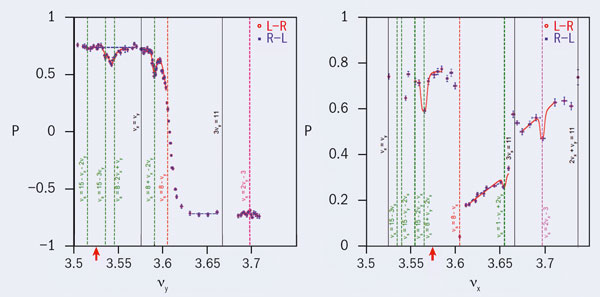
The SPIN@COSY polarized-beam team has found unexpectedly strong higher-order spin resonances when using 2.1 GeV/c polarized protons stored in the COSY COoler SYnchrotron at the Forschungszentrum Jülich. These results may help to increase the polarization in the Relativistic Heavy Ion Collider (RHIC) at Brookhaven when it is used as a 250 GeV/c polarized proton collider. The data were taken in April 2004 and presented in part at the International Spin Physics Symposium at Trieste the following September. However, the many partly overlapping data points had an unusually large scatter, so they allowed no firm conclusions to be reached. Now, after a challenging reanalysis, the team has published results that may spell good news for the work at RHIC.
In all of the other experiments by SPIN@COSY, the data showed the expected spread when beam parameters were varied upwards, e.g. in steps of 2, 4, 6, 8, 10 and then downwards, e.g. in steps of 9, 7, 5, 3, 1. However, this was not true for the April 2004 data. Indeed, when several of the sweeps were repeated for the second and third times, the data-spread increased. Clearly, these data needed a reanalysis, which began in 2009 after the other data from SPIN@COSY had been published.
The team obtained data for each resonance by measuring the polarization after sweeping COSY’s vertical (and later horizontal) betatron tunes slowly through the resonance with a narrow tune range of 0.002 in 2s, giving a tune sweep-rate of 0.001/s. The sweep-rate through all of the other resonances was made about 250 times faster by sweeping through a much larger range in a shorter time, typically a range of 0.125 in 0.5s. This reduced the effect of all of the other resonances by about 250-fold.
One possible cause of the spread in the data was a variation in the polarization stability of the polarized H– ion source. Polarized ion-sources are sensitive devices, with several sextupoles and RF transition units, whose fields and frequencies must be precisely matched to maximize the polarization. The source polarization at COSY is measured by a low-energy polarimeter (LEP) and the values stored on a nearby computer; but in 2004 this computer was not connected to the computers in the main control room, where the 2.1 GeV/c data were stored. Fortunately, however, the stored LEP data from 2004 were still available in 2009, so that several gigabytes of data could be transferred from COSY to Michigan. There, a small team of two post-docs and four undergraduate students matched the LEP data from the source in time with the corresponding 2.1 GeV/c data. When the 2.1 GeV/c polarization data were renormalized to the LEP polarization data, much of the spread disappeared.

The team then refined the vertical betatron-tune data further by using what is possibly a new technique for combining many partly overlapping data points in an unbiased manner. Thirty-six pairs of data points were sequentially recombined, whenever both lay within a sequentially increasing (in 0.001 steps) range in betatron tune. This recombination continued for 76 steps until the results of recombining the data from low-to-high vertical betatron tunes and from high-to-low tunes were all identical. In the horizontal data only five pairs of overlapping points needed to be recombined.
Figure 1 shows the results of this two-step reanalysis. The data clearly revealed that the long-held belief that lower-order spin resonances always caused more depolarization than higher-order resonances, and vertical spin resonances always caused more depolarization than horizontal resonances, was not correct for the 2nd- and 3rd-order resonances. The results showed that the single 2nd-order vertical resonance was far weaker than two of the 3rd-order vertical resonances (figure 2). They also showed that, while the 1st-order vertical resonance was so much stronger than the 1st-order horizontal resonance that it fully flipped the spin direction, this was certainly not true for the 2nd- and 3rd-order resonances. These unexpected results may help the RHIC polarized collider to increase its 250 GeV level of polarization further towards the 100 GeV level.
Further reading
M A Leonova et al. 2012 Phys. Rev. Letts. 108 074801.





